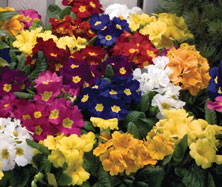8/25/2011
Lyrical Color: Piano Primula
Danny Brooks

It’s hard to beat the color range and flower power of a good crop of fall primula, but how do you produce a great looking crop from seed without vernalization? Here are a few tips to ensure great germination and a healthy looking crop.
Because they don’t require vernalization,
Primula elatior Piano series from Benary is a great choice for either fall or early spring production. They are a large flowered polyanthus type with a short flower stem compared to most polyanthus varieties. This allows the flowers to sit on top of the foliage rather than getting buried in the leaves. The result is a tidy plant habit with an incredible display of color. Here are our recommendations for growing Piano Primula.
Plug production
Germination: For the optimal germination yields, keep soil temperature at a cool 64F-68F (18C-20C). The threshold temperature for primula is 75F (23.5C). Higher temperatures will result in very poor germination. Primula do not require light to germinate, but very low light (10-100 footcandles) can prevent stretch in the seedlings. Keep seedlings moist at all times for the first seven to 10 days, then the soil moisture can be lowered, but the humidity needs to stay high until all the seeds have germinated. Keep the humidity level as close to 100% as possible for the first 10 days, then it can be lowered slightly to 80% until day 12-14. It can be lowered to as little as 40-60% for growing on. A very light covering of vermiculite at sowing will help keep humidity high around the seeds. Germination should occur in seven to 10 days.
Primula are very sensitive to high salts, so keep the pH between 5.5-5.8. (The pH needs to be kept below 6.0.) A pH above 6.2 can create a deficiency in iron and manganese, which causes the leaves to yellow. An EC of 0.5-0.75 is recommended.
Begin feeding at low rates at Day 14. Use 50 ppm of 17-5-17
or 14-4-14. After 21 days use 100 ppm of the 17-5-17 every second watering.
Growing on
Plug crop time: 6-7 weeks
Finish crop time: 12-14 weeks
There is no need for growth regulators when attention is paid to temperature, moisture management, fertilization and EC. By growing at lower fertilizer levels and lower temperatures, it seems to result in the best quality finished product.
After transplant, plants should be kept very moist for the first four to five days, then kept moist to medium. A constant feeding program can be used, or you can alternate between feeding and fresh watering.
For a constant feed program: Do not feed more than 100 ppm with a 17-5-17 feed or a 14-4-14 feed.
For an alternating feed/fresh water program: Use a 20-10-20 feed at 150 ppm, but only every third watering. If the plants seem to need more feed, increase your feeding more frequently.
By using an alternating feed method you can keep the plants under tighter control, preventing soft growth and strap-shaped leaves. When light levels decrease, switch feed to a more calcium-based fertilizer like a 14-4-14 or a 13-2-13. You can alternate between a 17-5-17 feed and a 14-4-14 or a 14-2-14 type of fertilizer. You may have to use a 20-10-20 on occasion.
Newly planted primula seedlings need to be protected from direct sun to prevent leaf scorch—40-60% shade is recommended. Shade plants until light levels and temperatures become more acceptable—around early September. When the plants start to grow softer and the leaves begin to elongate you can remove the shade.
Light levels of 2,000-2,500 footcandles are sufficient for good growth. Provide 3,000-4,000 footcandles to enhance flower development. Long days may enhance growth. Avoid extended light levels of over 3,500 footcandles (3,000 footcandles in the early stages of production).
When the plants reach the 6-8 true leaf stage, maintain day and night temperatures of 60F-65F (15C-18C). Vernalization is not required to initiate flowering, but primula prefer cool temperatures. Once plants are well established, the temperature can be lowered to as low as 35F-38F (2C-3C) if you need to slow the crop down. After four to five weeks of cooler temperatures you can raise the temperature to no more than 58F (14C).
Tips for success
- Being too wet can inhibit germination and effect the growth of seedlings—keep moist but not saturated. Grow drier during the later, cooler stages of production.
- Avoid high temperatures above 95F (34C) since this can cause blind plants.
- Shade plants with 40-60% shade cloth during high temperatures and at transplant.
- If plants are very dry, avoid feeding the plants since you can cause leaf-tip burn.
- Keep the pH below 6.2. Primula prefers a pH range of 5.5-5.8. Deficiencies are evident at a pH of 6.5. High pH will cause Iron and Manganese deficiencies.
- Keep the EC levels between 1.0-1.5 during finishing.
- Good ventilation, sufficient spacing and irrigation early in the morning help to avoid fungal diseases like Botrytis. GT
Danny Brooks is a product support specialist and culture advisor for Ernst Benary of America. You can reach him at dbrooks@benary.com.